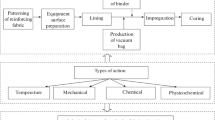Abstract
Different factors of technological heredity for parts prepared from metals and polymer composite materials are comparatively analyzed. The factors most affecting the inheritable information are considered, the influence of the transfer method is studied, and regions where inheritable information appears are listed. Technological links providing transfer of the inheritable information from one technological operation to another are considered.
Similar content being viewed by others
References
G. A. Rastorguev, “The manifestation of technological heredity in the operation of machinery and mechanisms,” Remont, Vosstanovlenie, Modernizatsiya, No. 12, 32–40 (2013).
Technological Maintenance and Improvement of Operational Properties of Details and Their Joints, Ed. by A. G. Suslov (Mashinostroenie, Moscow, 2006) [in Russian].
V. A. Zorin and N. I. Baurova, “Improvement of the safety of road-building machinery and equipment,” Nauka Tekhnika Dorozhnoi Otrasli, No. 1, 39–40 (2009).
I. V. Chudnov, E. Sh. Akhmetova, and G. V. Malysheva, “Features of studying the properties of hybrid polymer binders by differential scanning calorimetry,” Materialovedenie, No. 5, 22–25 (2013).
N. Yu. Taraskin, E. K. Filina, and G. V. Malysheva, “Features of the method for studying the properties of polymer composites by dynamomechanical analysis,” Vse Materialy. Entsiklopedicheskii Spravochnik, No. 7, 9–13 (2014).
N. I. Baurova, V. A. Zorin, and V. M. Prikhod’ko, “Description of scenarios of transition of material from an operable to inoperable state using an equation of fold catastrophe theory,” Polym. Sci. Ser. D 8(1), 1–5 (2015).
L. G. Petrova, “All-Russian Forum at AvtoVAZ “New steel for engineering and heat treatment,” Metalloved. Termich. Obrab. Metallov, No. 12, 54–56 (2011).
S. M. Terekhina, G. V. Malysheva, I. M. Bulanov, and T. V. Tarasova, “Investigation of tribological properties of polymer composite materials based on bismaleimide binder,” Polym. Sci. Ser. D 4(2), 136–137 (2011).
N. I. Baurova, “Development of bases of technological maintenance of machinery and monitoring changes in its technical condition with the use of nanostructured materials,” Doctoral Dissertation in Engineering (Mosk. Gos. Avtomob.-Dorozh. Univ., Moscow, 2010).
N. I. Baurova, “Microstructural investigations of surfaces of destruction of carbon plastic,” Polymer Sci. Ser. D 6(3), 246–249 (2013).
R. I. Nigmetzyanov, V. M. Prikhod’ko, and D. S. Fatyukhin, “Influence of combined vibroimpact and smoothing ultrasonic treatment on the wear of steel products,” Naukoemk. Tekhnol. Mashinostroen., No. 2 (32), 21–23 (2014).
Author information
Authors and Affiliations
Corresponding author
Additional information
Original Russian Text © N.I. Baurova, V.A. Zorin, V.M. Prikhodko, 2015, published in Vse Materialy. Entsiklopedicheskii Spravochnik, 2015, No. 2, pp. 2–7.
Rights and permissions
About this article
Cite this article
Baurova, N.I., Zorin, V.A. & Prikhodko, V.M. Technological heredity and identification of technological processes. Polym. Sci. Ser. D 8, 219–222 (2015). https://doi.org/10.1134/S199542121503003X
Received:
Published:
Issue Date:
DOI: https://doi.org/10.1134/S199542121503003X




